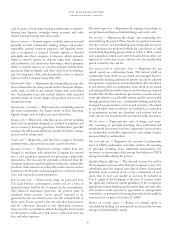American Express 2008 Annual Report Download - page 51
Download and view the complete annual report
Please find page 51 of the 2008 American Express annual report below. You can navigate through the pages in the report by either clicking on the pages listed below, or by using the keyword search tool below to find specific information within the annual report.2008 financial review
american express company
well as lower interest expense. Discount revenue, net card fees
and other of $10.4 billion in 2008, increased $114 million or
1 percent from 2007, due to higher other revenue, greater net
card fees and increased travel commissions and fees, which were
partially offset by lower commissions and fees. The increase in
billed business reflected a 2 percent increase in basic cards-in-
force, offset by a 3 percent decline in average basic cardmember
spending. Within U.S. Card Services, small business volumes
rose 7 percent in 2008, offset by a slight decrease in consumer
billed business. Interest income of $4.7 billion in 2008 was
$389 million or 8 percent lower than in 2007, primarily
due to lower market interest rate-driven yields and a slight
decrease in average owned lending balances. Interest expense
of $2.2 billion in 2008, decreased $487 million or 18 percent as
compared to a year ago, primarily due to a lower cost of funds.
Total revenues net of interest expense of $14.2 billion in 2007
were $1.6 billion or 13 percent higher than 2006 as a result of higher
interest income, increased discount revenue, net card fees and other,
and greater securitization income, net, partially offset by increased
interest expense.
Provisions for Losses
Provisions for losses increased $1.4 billion or 46 percent to
$4.4 billion for 2008 compared to 2007, due to higher write-
off and delinquency rates in the lending and charge portfolios
reflecting the challenging U.S. credit environment. Provisions
for losses increased $1.4 billion or 84 percent to $3.0 billion
for 2007 compared to 2006, reflecting increased write-off and
delinquency rates, the impact of loan growth, and the credit-
related charge previously discussed.
Expenses
During 2008, U.S. Card Services’ expenses decreased $ 27 million
or less than 1 percent to $8.5 billion, due to lower marketing,
promotion, rewards and cardmember services expenses,
partially offset by greater salaries and employee benefits and
other operating expenses. Expenses in 2008, 2007, and 2006,
included $30 million, $13 million, and $23 million, respectively,
of charges related to reengineering activities primarily related
to the Company’s reengineering initiative in 2008 as previously
discussed and reengineering activities within consumer and
small business services in 2007 and 2006. Expenses in 2007
of $8.5 billion were $822 million or 11 percent higher than in
2006, primarily due to higher marketing, promotion, rewards
and cardmember services expenses, and greater salaries and
employee benefits and other operating expenses.
Marketing, promotion, rewards and cardmember services
expenses decreased $303 million or 6 percent in 2008 to
$4.8 billion, due to the Membership Rewards related charge in
2007 noted above, the incremental business-building expenses
in 2007 compared to lower marketing and promotion expenses
in 2008, partially offset by the Delta-related charge in 2008 to
increase the Membership Rewards liability and higher volume-
related rewards costs. Marketing, promotion, rewards and
cardmember services expenses increased $695 million or 16
percent in 2007 to $5.1 billion, reflecting the increase to the
Membership Rewards liability resulting from enhancements to
the method of liability estimation, a higher redemption rate, and
higher volume-driven rewards costs, partially offset by slightly
lower marketing and promotion expenses and the charges
associated with adjustments made to the U.S. Membership
Rewards reserve model in 2006. Salaries and employee benefits
and other operating expenses of $3.6 billion in 2008 increased
$276 million or 8 percent from 2007. The increase was due to
higher software, operations, technology and credit and collection
costs, the pension-related gain in 2007 and costs related to
the Company’s reengineering initiatives in 2008. Salaries and
employee benefits and other operating expenses of $3.4 billion in
2007 increased $127 million or 4 percent from 2006. The increase
was due to higher technology and volume-related operating
expenses, partially offset by the previously discussed pension-
related gain of $36 million in 2007 and the reclassification to
revenues of certain card acquisition-related costs beginning in
the third quarter of 2006 as discussed previously.
Income Taxes
The effective tax rate was 25 percent for 2008 compared to
33 percent and 35 percent for 2007 and 2006, respectively. The
effective tax rate for 2008 and 2007 reflected benefits related to the
resolution of certain prior years’ tax items and in 2008, a relatively
lower level of pretax income.
differences between gaap and managed
basis presentation
For U.S. Card Services, the managed basis presentation assumes
that there have been no off-balance sheet securitization
transactions, i.e., all securitized cardmember loans and related
income effects are reflected as if they were in the Company’s
balance sheets and income statements, respectively. For the
managed basis presentation, revenue and expenses related to
securitized cardmember loans are reflected in other commissions
and fees (included in discount revenue, net card fees and other
in the U.S. Card Services Selected Financial Information),
interest income, interest expense, and provisions for losses.
On a managed basis, there is no securitization income, net
as the managed basis presentation assumes no securitization
transactions have occurred.
The Company presents U.S. Card Services information
on a managed basis because that is the way the Company’s
management views and manages the business. Management
believes that a full picture of trends in the Company’s
cardmember lending business can only be derived by evaluating
the performance of both securitized and non-securitized
49
























